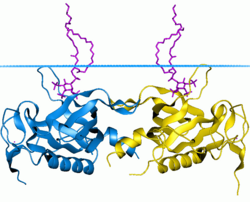Plekstrinski homologni domen
Plekstrinski homologni domen (PH domen) je proteinski domen sa približno 120 aminokiselina. On se javlja u širokom opsegu proteina koji učestvuju u intraćelijskoj signalizaciji ili su konstituenti citoskeletona.[1][2][3][4][5][6][7]
 PH domen tirozinske proteinske kinaze BTK | |||||||||
| Identifikatori | |||||||||
|---|---|---|---|---|---|---|---|---|---|
| Simbol | PH | ||||||||
| Pfam | PF00169 | ||||||||
| InterPro | IPR001849 | ||||||||
| SMART | PH | ||||||||
| PROSITE | PDOC50003 | ||||||||
| SCOP | 1dyn | ||||||||
| SUPERFAMILY | 1dyn | ||||||||
| OPM superfamilija | 51 | ||||||||
| OPM protein | 1pls | ||||||||
| CDD | cd00821 | ||||||||
| |||||||||
Ovaj domen je prisutan u fosfatidilinozitolnim lipidima unutar bioloških membrana (kao što je fosfatidilinozitol (3,4,5)-trisfosfat i fosfatidilinozitol (4,5)-bisfosfat),[8] i proteinima poput βγ-podjedinica heterotrimernih G proteina,[9] i proteinske kinaze C.[10] Putem tih interakcija, PH domeni učestvuju u regruitovanju proteina u različite membrane, te ih sortiraju u odgovarajuće ćelijske kompartmane ili im omogućavaju da formiraju interakcije sa drugim komponentama puteva prenosa signala.
Potfamilije уреди
Primeri уреди
Sledeći geni kodiraju proteine sa PH domenom:
- ABR, ADRBK1, ADRBK2, AFAP, AFAP1, AFAP1L1, AFAP1L2, AKAP13, AKT1, AKT2, AKT3, ANLN, APBB1IP, APPL1, APPL2, ARHGAP10, ARHGAP12, ARHGAP15, ARHGAP21, ARHGAP22, ARHGAP23, ARHGAP24, ARHGAP25, ARHGAP26, ARHGAP27, ARHGAP9, ARHGEF16, ARHGEF18, ARHGEF19, ARHGEF2, ARHGEF3, ARHGEF4, ARHGEF5, ARHGEF6, ARHGEF7, ARHGEF9, ASEF2,
- BMX, BTK,
- C20orf42, C9orf100, CADPS, CADPS2, CDC42BPA, CDC42BPB, CDC42BPG, CENTA1, CENTA2, CENTB1, CENTB2, CENTB5, CENTD1, CENTD2, CENTD3, CENTG1, CENTG2, CENTG3, CIT, CNKSR1, CNKSR2, COL4A3BP, CTGLF1, CTGLF2, CTGLF3, * CTGLF4, CTGLF5, CTGLF6,
- DAB2IP, DAPP1, DDEF1, DDEF2, DDEFL1, DEF6, DEPDC2, DGKD, DGKH, DGKK, DNM1, DNM2, DNM3, DOCK10, DOCK11, DOCK9, DOK1, DOK2, DOK3, DOK4, DOK5, DOK6, DTGCU2,
- EXOC8,
- FAM109A, FAM109B, FARP1, FARP2, FGD1, FGD2, FGD3, FGD4, FGD5, FGD6,
- GAB1, GAB2, GAB3, GAB4, GRB10, GRB14, GRB7,
- IRS1, IRS2, IRS4, ITK, ITSN1, ITSN2,
- KALRN, KIF1A, KIF1B, KIF1Bbeta,
- MCF2, MCF2L, MCF2L2, MRIP, MYO10,
- NET1, NGEF,
- OBPH1, OBSCN, OPHN1, OSBP, OSBP2, OSBPL10, OSBPL11, OSBPL3, OSBPL5, OSBPL6, OSBPL7, OSBPL8, OSBPL9,
- PHLDA2, PHLDA3, PHLDB1, PHLDB2, PHLPP, PIP3-E, PLCD1, PLCD4, PLCG1, PLCG2, PLCH1, PLCH2, PLCL1, PLCL2, PLD1, PLD2, PLEK, PLEK2, PLEKHA1, PLEKHA2, PLEKHA3, PLEKHA4, PLEKHA5, PLEKHA6, PLEKHA7, PLEKHA8, PLEKHB1, PLEKHB2, PLEKHC1, PLEKHF1, PLEKHF2, PLEKHG1, PLEKHG2, PLEKHG3, PLEKHG4, PLEKHG5, PLEKHG6, PLEKHH1, PLEKHH2, PLEKHH3, PLEKHJ1, PLEKHK1, PLEKHM1, PLEKHM2, PLEKHO1, PLEKHQ1, PREX1, PRKCN, PRKD1, PRKD2, PRKD3, PSCD1, PSCD2, PSCD3, PSCD4, PSD, PSD2, PSD3, PSD4, RALGPS1, RALGPS2, RAPH1,
- RASA1, RASA2, RASA3, RASA4, RASAL1, RASGRF1, RGNEF, ROCK1, ROCK2, RTKN,
- SBF1, SBF2, SCAP2, SGEF, SH2B, SH2B1, SH2B2, SH2B3, SH3BP2, SKAP1, SKAP2, SNTA1, SNTB1, SNTB2, SOS1, SOS2, SPATA13, SPNB4, SPTBN1, SPTBN2, SPTBN4, SPTBN5, STAP1, SWAP70, SYNGAP1,
- TBC1D2, TEC, TIAM1, TRIO, TRIOBP, TYL,
- URP1, URP2,
- VAV1, VAV2, VAV3, VEPH1
Reference уреди
- ^ Mayer BJ, Ren R, Clark KL, Baltimore D (1993). „A putative modular domain present in diverse signaling proteins”. Cell. 73 (4): 629—30. PMID 8500161. doi:10.1016/0092-8674(93)90244-K.
- ^ Haslam RJ, Koide HB, Hemmings BA (1993). „Pleckstrin domain homology”. Nature. 363 (6427): 309—10. PMID 8497315. doi:10.1038/363309b0.
- ^ Musacchio A, Gibson T, Rice P, Thompson J, Saraste M (1993). „The PH domain: a common piece in the structural patchwork of signalling proteins”. Trends Biochem. Sci. 18 (9): 343—8. PMID 8236453. doi:10.1016/0968-0004(93)90071-T.
- ^ Gibson TJ, Hyvönen M, Musacchio A, Saraste M, Birney E (1994). „PH domain: the first anniversary”. Trends Biochem. Sci. 19 (9): 349—53. PMID 7985225. doi:10.1016/0968-0004(94)90108-2.
- ^ Pawson T (1995). „Protein modules and signalling networks”. Nature. 373 (6515): 573—80. PMID 7531822. doi:10.1038/373573a0.
- ^ Ingley E, Hemmings BA (1994). „Pleckstrin homology (PH) domains in signal transduction”. J. Cell. Biochem. 56 (4): 436—43. PMID 7890802. doi:10.1002/jcb.240560403.
- ^ Saraste M, Hyvönen M (1995). „Pleckstrin homology domains: a fact file”. Curr. Opin. Struct. Biol. 5 (3): 403—8. PMID 7583640. doi:10.1016/0959-440X(95)80104-9.
- ^ Wang DS, Shaw G (1995). „The association of the C-terminal region of beta I sigma II spectrin to brain membranes is mediated by a PH domain, does not require membrane proteins, and coincides with a inositol-1,4,5 triphosphate binding site”. Biochem. Biophys. Res. Commun. 217 (2): 608—15. PMID 7503742. doi:10.1006/bbrc.1995.2818.
- ^ Wang DS, Shaw R, Winkelmann JC, Shaw G (1994). „Binding of PH domains of beta-adrenergic receptor kinase and beta-spectrin to WD40/beta-transducin repeat containing regions of the beta-subunit of trimeric G-proteins”. Biochem. Biophys. Res. Commun. 203 (1): 29—35. PMID 8074669. doi:10.1006/bbrc.1994.2144.
- ^ Yao L, Kawakami Y, Kawakami T (1994). „The pleckstrin homology domain of Bruton tyrosine kinase interacts with protein kinase C”. Proc. Natl. Acad. Sci. U.S.A. 91 (19): 9175—9. PMC 44770 . PMID 7522330. doi:10.1073/pnas.91.19.9175.
Vidi još уреди
Spoljašnje veze уреди
- Nash Lab Protein Interaction Domains - PH domain description[мртва веза]
- UMich orijentacija proteina u membranama families/superfamily-51 - Calculated orientations of PH domains in membranes